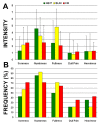The temporal-spatial encoding of acupuncture effects in the brain
- PMID: 21429192
- PMCID: PMC3071327
- DOI: 10.1186/1744-8069-7-19
The temporal-spatial encoding of acupuncture effects in the brain
Abstract
Background: Functional acupoint specificity is crucial to the clinical efficacy of acupuncture treatment, such as pain relief. Whether acupuncture needling at a peripheral acupoint produces distinct patterns of brain responses remains controversial.
Results: This fMRI study employed the complex network analysis (CNA) to test the hypothesis that acupuncture stimulation at an acupoint correspondingly induced activity changes in one or more intrinsic or resting-state brain networks. Built upon the sustained effect of acupuncture and its time-varying characteristics, we constructed a dynamic encoding system with the hub anchored at the posterior cingulate cortex and precuneus (PCC/pC). We found that needling at two visual acupoints (GB37 and BL60) and a non-visual acupoint (KI8) induced a spatially converging brain response, which overlapped at the PCC/pC. We also found distinct neural modulations during and after acupoint stimulation. During this period, the PCC/pC interacted with a visual resting-state network in different patterns. Furthermore, there was a delayed functional correspondence between the intrinsic visual network and manipulation over the visual acupoints (i.e., GB37 or BL60), but not the non-visual acupoint (KI8) via the PCC/pC, implicating a specific temporal-spatial encoding/decoding mechanism underlying the post-effect of acupuncture.
Conclusions: This study provided an integrated view exploring the functional specificity of acupuncture in which both the needling sensation and the following neural cascades may contribute to the overall effect of acupuncture through dynamic reconfiguration of complex neural networks.fMRI, acupoints, posterior cingulate cortex, precuneus, temporal-spatial encoding, resting-state networks.
Figures






Similar articles
-
Partial correlation investigation on the default mode network involved in acupuncture: an fMRI study.Neurosci Lett. 2009 Oct 25;462(3):183-7. doi: 10.1016/j.neulet.2009.07.015. Epub 2009 Jul 10. Neurosci Lett. 2009. PMID: 19595739
-
A study of the brain functional network of Deqi via acupuncturing stimulation at BL40 by rs-fMRI.Complement Ther Med. 2016 Apr;25:71-7. doi: 10.1016/j.ctim.2016.01.004. Epub 2016 Jan 14. Complement Ther Med. 2016. PMID: 27062952
-
Acupuncture modulates temporal neural responses in wide brain networks: evidence from fMRI study.Mol Pain. 2010 Nov 2;6:73. doi: 10.1186/1744-8069-6-73. Mol Pain. 2010. PMID: 21044291 Free PMC article. Clinical Trial.
-
Effects of acupuncture needling with specific sensation on cerebral hemodynamics and autonomic nervous activity in humans.Int Rev Neurobiol. 2013;111:25-48. doi: 10.1016/B978-0-12-411545-3.00002-X. Int Rev Neurobiol. 2013. PMID: 24215916 Review.
-
[Complex network analysis on regularities of acupoint combinations and application characteristics of acupuncture and moxibustion in the treatment of knee osteoarthritis].Zhen Ci Yan Jiu. 2022 Jan 25;47(1):65-70. doi: 10.13702/j.1000-0607.20210080. Zhen Ci Yan Jiu. 2022. PMID: 35128873 Review. Chinese.
Cited by
-
Two sets of acupoint combination of similar functions engage shared neural representation: a functional magnetic resonance imaging study.Chin J Integr Med. 2014 Mar;20(3):184-93. doi: 10.1007/s11655-014-1744-3. Epub 2014 Mar 4. Chin J Integr Med. 2014. PMID: 24615211 Clinical Trial.
-
Peripheral ERK modulates acupuncture-induced brain neural activity and its functional connectivity.Sci Rep. 2021 Mar 4;11(1):5128. doi: 10.1038/s41598-021-84273-y. Sci Rep. 2021. PMID: 33664320 Free PMC article.
-
Progress of Acupuncture Therapy in Diseases Based on Magnetic Resonance Image Studies: A Literature Review.Front Hum Neurosci. 2021 Aug 20;15:694919. doi: 10.3389/fnhum.2021.694919. eCollection 2021. Front Hum Neurosci. 2021. PMID: 34489662 Free PMC article. Review.
-
The modulation effect of longitudinal acupuncture on resting state functional connectivity in knee osteoarthritis patients.Mol Pain. 2015 Oct 29;11:67. doi: 10.1186/s12990-015-0071-9. Mol Pain. 2015. PMID: 26511911 Free PMC article. Clinical Trial.
-
Altered hub configurations within default mode network following acupuncture at ST36: a multimodal investigation combining fMRI and MEG.PLoS One. 2013 May 17;8(5):e64509. doi: 10.1371/journal.pone.0064509. Print 2013. PLoS One. 2013. PMID: 23691237 Free PMC article.
References
-
- Hughes E, Barrows K. In: Current Medical Diagnosis and Treatment. McPhee SJ, editor. Papadakis MA; 2010. Complementary and Alternative Medicine.
Publication types
MeSH terms
LinkOut - more resources
Full Text Sources
Medical

